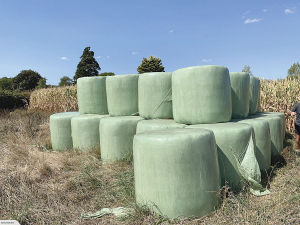Grass silage begins to break down once exposed to air, making steps to reduce losses crucial.
Losses occur as sugars and protein in the grass are broken down by enzymes and bacteria. This process starts as soon as the grass is cut. Losses decrease quality as well as quantity because it is the highly digestible components which are most rapidly broken down.
According to DairyNZ, silage will begin to heat up as micro-organisms turn the remaining sugars and protein into heat and energy.
When feeding out, aim for as little time as possible between exposing the silage to air, and the cow eating it.
There are several ways to limit losses from silage while feeding out:
- Remove at least 20cm off the whole stack face each day, so silage at the face is not exposed to air for a more than one day.
- Cut silage off the face, rather than pulling it off. This keeps a smooth surface at the stack face, which reduces air penetration into the stack.
- Leave the stack face open on dry days to avoid heat build-up under the polythene.
- Do not feed out more than one day in advance, especially in summer.
- Cows will be able to eat more of the silage they are offered if it is fed out on dry paddocks or feed out areas, along fence lines, or in feed bins or troughs.
- Do not allow cows access to spoiled silage.
Assessing quality
If you don’t have a feed analysis for your silage, you can estimate quality from its appearance.
Feed quality: High quality silage has lots of leaf, and very little stem in it. The more stem in silage, the poorer its quality.
Colour: Well-preserved silages are green, yellow, or pale brown. Dark brown silage is generally poorly preserved.
Smell: Well preserved silage has a sweet, tobacco smell. Foul, rancid smells indicate the presence of butyric acid from poor preservation.
Moulds: Moulds grow where silage has been exposed to air. Some fungi can produce toxins.











